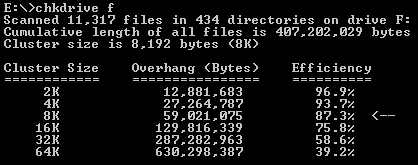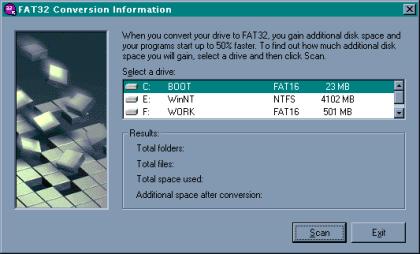
Contents
Introduction
Disk Efficiency
Features
Compatibility Considerations
Performance
Dual-Boot Computers
Creating FAT32
Drives
thank you for visiting the FAT32 resource page, this site explains all the options and specifications of the new FAT32 file system for Windows. This page has been created to help answer some of the questions and confusions about FAT32 and its new features.
| New! CheckDrive, a free dos utility that helps to calculate how much space could be gained with the use of FAT32. |
Introduction
FAT32 is an enhancement of the File Allocation Table file system that supports large drives with improved disk space efficiency. FAT32 is only currently supported by two operating systems:-
![]() OEM Service Release 2 (OSR2) of Microsoft Windows 95 (commonly known as Windows95b). This release of windows was released in the fall of 1996, and is only available with new PC's.
OEM Service Release 2 (OSR2) of Microsoft Windows 95 (commonly known as Windows95b). This release of windows was released in the fall of 1996, and is only available with new PC's.
![]() Windows 98, FAT32 is included in the final release of the Windows 98 operating system. It also includes a FAT32 converter so you can convert an existing FAT drive to FAT32 without data loss.
Windows 98, FAT32 is included in the final release of the Windows 98 operating system. It also includes a FAT32 converter so you can convert an existing FAT drive to FAT32 without data loss.
The existing File Allocation Table (FAT) file system was invented in 1977 as a way to store data on floppy disks for Microsoft stand-alone Disk Basic. Although originally intended for floppy disks, FAT has since been modified to be a fast, and flexible system for managing data on both removable and fixed media. The current generation of large hard disks have finally reached the limit of the existing FAT data structures. FAT currently can support a single disk volume up to 2 Gigabytes in size, with the increasing size of new hard drives this is an increasing problem.
Disk Efficiency
![]()
Every file on your system is stored in clusters in your hard drive, the maximum of one file can be stored in a particular cluster, so this results in wastage if the file is under the cluster size. The current FAT version (FAT16) organises files in 32K clusters in drives over 1.2gig, while FAT32 will use a minimum cluster size of 4K. This means that a 3K file wastes only 1K of disk space on FAT32, while it wastes 29K of space on a standard FAT system. This wastage can result in over 50% of a 2gig drive being wasted. See the table below.
Average Cluster Efficiency
Note: Disk Size does not apply to FAT32 where the 4K cluster is usually used.
Cluster Size
Efficiency
Disk Size
(applies to standard FAT only)
2K
98.4%
0-127 MB
4K
96.6%
128-255 MB
8K
92.9%
256-511 MB
16K
85.8%
512-1023 MB
32K
73.8%
1024-2047 MB
64K
56.6%
2047 MB >
Features
FAT32 provides the following enhancements over previous implementations of the FAT tile system:
![]() Supports up to 2 terabytes in size.
Supports up to 2 terabytes in size.
![]() Uses space more efficiently: FAT32 uses smaller clusters (e.g. 4kg clusters for drives up to 8GB in size), resulting in IO to I 5% more efficient use of disk space relative to large FAT drives.
Uses space more efficiently: FAT32 uses smaller clusters (e.g. 4kg clusters for drives up to 8GB in size), resulting in IO to I 5% more efficient use of disk space relative to large FAT drives.
FAT32 Cluster Sizes and Efficiency
Note: The minimum size for a FAT32 partition is about 260 MB.
Disk Size
Cluster Size
Efficiency
> 260meg
4K
96.6%
> 8gig
8K
92.9%
> 60gig
16K
85.8%
> 2tril
32K
73.8%
![]() More robust: FAT32 has the ability to relocate the root directory and use the backup copy of the FAT instead of the default copy. In addition, the boot record on FAT32 drives has been expanded to include a backup of critical data structures. This means that FAT32 drives are less susceptible to a single point of failure than existing FAT volumes.
More robust: FAT32 has the ability to relocate the root directory and use the backup copy of the FAT instead of the default copy. In addition, the boot record on FAT32 drives has been expanded to include a backup of critical data structures. This means that FAT32 drives are less susceptible to a single point of failure than existing FAT volumes.
![]() More flexible: The root directory of a FAT32 drive is now an ordinary cluster chain, so it can be abnormally large and located anywhere on the drive. In addition, FAT mirroring can be disabled, allowing a copy of the FAT other than the first to be active. These features allow for dynamic re-sizing of FAT32 partitions. Note: while the FAT32 design allows for this compatibility, it is not implemented by Microsoft in the initial release of OSR2.
More flexible: The root directory of a FAT32 drive is now an ordinary cluster chain, so it can be abnormally large and located anywhere on the drive. In addition, FAT mirroring can be disabled, allowing a copy of the FAT other than the first to be active. These features allow for dynamic re-sizing of FAT32 partitions. Note: while the FAT32 design allows for this compatibility, it is not implemented by Microsoft in the initial release of OSR2.
Compatibility Considerations
In order to maintain the greatest compatibility possible with existing applications, networks and device drivers, FAT32 was implemented with as little change as possible to Windows 95's existing architecture, internal data structures, Application Programming interfaces (API's) and on-disk format. However, because 4 bytes are now required to store cluster values, many internal add on-disk data structures and published APf's will fail on FAT32 drives. Most applications will be unaffected by these changes. Existing utilities and drivers should continue to work on FAT32 drives. however, MS-DOS block device drivers (e.g. ASPIDISK.SYS) and disk utilities for these will need to be revised to support FAT32 drives.
All of Microsoft's bundled disk utilities in Windows95b (format, FDISK, Defrag, MS-DOS and Windows Scandisk, and DriveSpace) have been revised to work with FAT32. In addition, Microsoft is working with leading device driver and disk utility vendors to support them in revising their products to support FAT32. Norton Utilities version 2 for Windows 95 fully supports FAT32.
Performance
For most users, FAT32 will have a negligible performance impact. Some applications may see a slight performance gain from FAT32. In other applications, particularly those heavily dependent on large sequential write operations, FAT32 may result in a modest performance degradation. The overall effect on raw disk performance is less than 5% however, and the overall impact on application performance as measured by Winstone is typically less than 1%. Drive defragmenting becomes a lengthy process due to the large number of clusters.
Dual-Boot Computers
At this time, Windows 95 OEM Service Release 2 and Windows 98 are the only operating systems capable of accessing FAT32 volumes. Windows 3.1, MS-DOS and the original version of Windows 95 will not recognise FAT32 partitions, and thus they are unable to boot from a FAT32 volume. Microsoft plans to add support for FAT32 in Windows NT5, but at this time , Windows NT is unable to access, or dual boot from FAT32 volumes. At minimum, Microsoft will provide a utility to convert a FAT32 volume to an NTFS volume in NT5. However, there is a free FAT32 reader available for NT from SytemInternals, there is also a read/write edition available for around $40. However, you cannot use the program to boot NT off a FAT32 partition.
Customers who run Windows 95 real mode (for example, to run a game) will be able to use FAT32 volumes. Windows95/98 protected DOS mode does include the FAT32 driver.
Creating FAT32 Drives
There are only currently three ways of creating a FAT32 partition:-
1. In OEM Service release 2, if you run the FDISK utility on a large system with a drive over 512MB, it will ask whether to enable large disk support. If you answer yes, any partition you create that's greater than 5I2MB will be marked as a FAT32 partition. FDISK cannot convert a FAT16 partition to FAT32, all contents of the drive are lost if you use this method.
2. Partition Magic 3 can convert partitions to FAT32 on-the-fly without data loss, this is probably the best method currently available, it can also convert back to FAT16 if required. See the PowerQuest site for more information on this product.
3. Windows 98 includes a graphical FAT32 conversion utility, which quickly and safely converts a hard drive from the original FAT to FAT32. You can also start FAT32 Converter by clicking Start, Programs, Accessories, System Tools, and then clicking FAT32 Converter.
Notes on the Windows 98 FAT32 converter: If you convert your hard drive to FAT32, then you cannot uninstall Windows 98 without reformatting. Once you convert your hard drive to the FAT32 format, you cannot return to using the FAT16 format unless you repartition and format the FAT32 drive. If you converted the drive on which Windows 98 is installed using FDISK, then you must reinstall Windows 98 after repartitioning the drive, you do not have to do this if using the converter.
The converter also requires drives to be over 512meg to be converted even though the actual FAT32 standard allows drives as small as 260 MB to be created. The 512 MB limit was probably set by Microsoft to gain maximum performance on FAT32 drives.
Important: Before you perform any function on your hard disk, it's a good idea to backup all your data. Also create a new Windows 95 startup disk!
Why Not Just Add NTFS To Windows95/98?
NTFS is an advanced file system, with support for many features not present in FAT32, including per-file compression, security and transactioning. It is not feasible to implement NTFS within the memory and compatibility constraints of the Windows 95 platform. Windows 95 still supports real-mode MS-DOS for booting and running some MS-DOS based games. Adding NTFS support to the MS-DOS kernel would have required a significant amount of MS-DOS memory, and that would have precluded the use of many MS-DOS mode games and applications. Protected-mode's only support for NTFS would not have allowed Windows to boot from an NTFS volume. However, there is a free NTFS reader for DOS/Windows9x available from SystemInternals. Note : this only supports read-only operations.
Technical Implementation
Because of the compatibility considerations described above, the implementation of FAT32 involved very little change to Windows 95. The Major differences between FAT32 and earlier implementations of FAT are as follows:
Notes
Downloads
CheckDrive - is a free dos utility that scans your hard disk and calculates your cluster efficiency. It displays the space wastage of your data on different cluster sizes, and which cluster size is currently being used. It also produces a FAT efficiency percentage. This program helps to calculate how much space could be gained with the use of FAT32.

Download
FAT32 Conversion Information - a small program produced by Microsoft which allows you to scan your existing FAT16 partitions and find out how much additional disk space you would gain from FAT32.

Download
Back To Top
